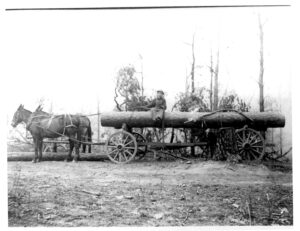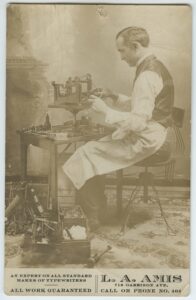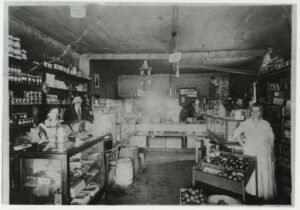Labor
In this activity, you will look at seven black and white photos that show the wood industry in Arkansas in the early 1900s (early 20th century). Wood is a very important natural resource. In the past, it was the most popular building material, and it was used for fuel. Today, wood is still used to build new buildings, make furniture, and even to make toys and toothpicks.
The large and rich forests of Arkansas made the wood industry one of the most important industries of the state in the past. Photos used in this activity will help us understand how over one hundred years ago trees were cut down, transported, and transformed into lumber. We will explore which parts of this process were done by people, which by machines, and how animals worked too.
In the past, all work was done by people. People made everything by hand, even tools that they used. Around three hundred years ago, that began to change. Scientists and inventors started building machines that were used to do work that was earlier done by people. This process of building and using machines to do work that in the past people had to do by hand is called industrialization.
The invention of machines changed how people worked. Some jobs became less needed because machines did what people used to do. For example, there were shoemakers in nearly every town, city, and village in the past. Shoemakers made new shoes and fixed old broken shoes. Everyone needed their services because people needed shoes to wear every day. Today, most shoes are made in factories and many people buy new shoes when their old shoes break, so much fewer shoemakers are needed.
Other jobs were created because machines created new needs. There were workers needed to operate machines, to fix them when they broke, or to supply fuel for machines to work. For example, think about cars. Before cars were invented, we did not need car mechanics, drivers, or gas station workers because we did not even need gas stations. We also did not need as many roads, which are built by workers who use materials that are supplied by other workers.
In this activity, you will look at five black and white photos that show how machines changed what workers did in the past. They will help us understand how industrialization created new needs and new jobs even if machines made some jobs less needed.
Note for educators: Some photos used in this activity document obsolete technology that will likely be unrecognizable to students. We recommend using this activity in class rather and as a homework assignment unless relevant background information is provided prior to assigning this activity to students.
What we buy, how we buy things, and where we shop have been changing. In the past, people shopped at markets, where they could buy everything that they needed. Later, people shopped in small family-owned shops. Some shops were selling things that shop owners bought from people who produced them (producers). For example, butchers sold meat that they bought from farmers who had livestock, and florists sold flowers that others cultivated on their farms. Other shops made things that they sold. For example, bakeries sold bread that they baked, and tailor shops sold clothes that they sew.
In the late 1800s (19th century), big department stores became popular. They sold many items in one large building, from clothes and shoes to kitchen equipment and furniture. In the 1900s (20th century), small family-owned shops were slowly replaced by big stores and shopping malls. Instead of buying groceries at a neighborhood corner store, people started shopping in big grocery stores that are still popular today. Or, instead of going to a local tailor shop to get their dresses or pants made by a seamstress or a tailor, customers went to shopping malls where they could buy ready-made clothes.
Today, we often buy things on the Internet. Sometimes we do not need to go to a store at all because what we need arrives in our homes in packages by mail. In this activity, you will look at six black and white photos that show historical stores and shops. They will help us understand who worked in stores and shops in the past, where customers typically shopped, and what kind of items they bought.
In the past, all work was done by people. People made everything by hand, even tools that they used. Around three hundred years ago, that began to change. Scientists and inventors started building machines that were used to do work that was earlier done by people. This changed how people lived and how they worked.
Some occupations became less needed or even disappeared because machines replaced people and technology changed what we need. For example, before electric lamps were invented, gas lamps were used to light up city streets. Individuals known as lamplighters walked around city streets every evening to light up each lamp by hand. They also returned in the early morning to put the lamps out. Today, we no longer need lamplighters because electric street lamps turn themselves on and off automatically.
Other occupations changed because workers could now use machines. For example, in the past, farmers did everything by hand or with the help of animals. They used only simple tools. Today, farmers use many types of machines that make work on a farm faster and easier. For example, farmers today can use tractors to pull heavy equipment (like a plow) while in the past they had to pull it by hand or use a horse or an ox to do it.
The development of technology also created occupations that did not exist before. For example, the invention of cars created the occupation of a car mechanic while the invention of the computer created the occupation of a computer programmer.
In this activity, you will look at seven black and white photos that show the workers of the past. Some of them used machines in their work, while others did not. Some occupations that you will see in the photos no longer exist while others are still common. Photos used in this activity will help us understand how people worked in the past and how technology changed nearly all jobs and occupations.
Note for educators: Some photos used in this activity document obsolete technology that will likely be unrecognizable to students. We recommend using this activity in class rather and as a homework assignment unless relevant background information is provided prior to assigning this activity to students.





